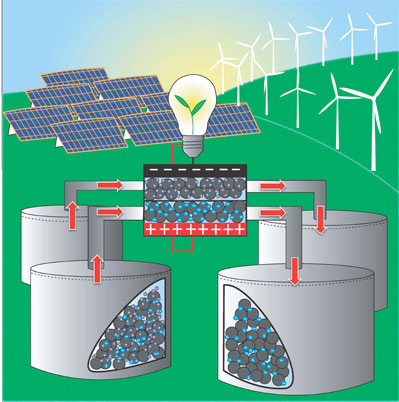This new technology, dubbed the “electrochemical flow capacitor,” stores energy in the same way as a supercapacitor, but is much less costly to scale up for large, industrial applications. Results from the team’s most recent study were published in a special issue of Advanced Energy Materials ("The Electrochemical Flow Capacitor: A New Concept for Rapid Energy Storage and Recovery") focusing on next-generation batteries.
The electrochemical flow capacitor uses a flow cell architecture, similar to existing redox flow batteries for grid storage, consisting of an electrochemical cell connected to external electrolyte reservoirs. However, this technology is unique in that it uses a flowable slurry of capacitive particles suspended in a liquid electrolyte carrier fluid. Uncharged slurry is pumped through a flow cell, where energy is stored capacitively within the solid particles.The charged slurry can then be held in reservoirs until the energy is needed, at which time the entire process is reversed. By utilizing this capacitive slurry instead of conventional battery electrolytes, the Drexel team says that its new design can be operated in high power applications for hundreds of thousands of charge-discharge cycles, vital for industrial applications

llustration by Kristy Jost, PhD student of Materials Science and Engineering.
“It is well known that conventional supercapacitors provide very high power output with minimal degradation in performance. However, they have always had fairly limited energy storage capacity”, said Dr. Yury Gogotsi, distinguished university professor and Trustee Chair of Materials Science and Engineering and director of the A.J. Drexel Nanotechnology Institute at Drexel University, one of the lead scientists on the project. “By incorporating the active material of supercapacitors into a fluid, we are able to address issues of capacity and scalability by adopting the system architecture from redox flow batteries”.
Dr. E. C. Kumbur, Director of the Electrochemical Energy Systems Laboratory at Drexel states: “Flow battery architecture is very attractive for grid-scale applications because it allows for scalable energy storage by decoupling the power and energy storage.” In flow battery systems, as well as the electrochemical flow capacitor, the energy storage capacity is determined by the size of the reservoirs which store the charged material. If a larger capacity is desired, the tanks can simply be scaled up in size. Similarly, the power output of the system is controlled by the size of the electrochemical cell, with larger cells producing more power.
“Slow response rate is a common problem for most energy storage systems. Incorporating the rapid charging and discharging ability of supercapacitors into this architecture is a major advantage to effectively store the fluctuating energy sources and deliver the energy rapidly as needed,” Kumbur said. “Electrical energy storage is the bottleneck for more widespread implementation of renewable energy sources like wind and solar,” said Dr. Volker Presser, Assistant Research Professor in the Department of Materials Science and Engineering at Drexel. “We believe that this new technology has important applications in that field. Moreover, these technologies can also be used to enhance the efficiency of existing power sources, and improve the stability of the grid.”
The team’s ongoing work is focused on developing new slurry compositions based on different carbon nanomaterials and electrolytes, as well as optimizing their flow capacitor design.
“We have observed very promising performance so far, but this is by no means the upper limit of this technology,” Gogotsi said. The team is also designing a small demonstration prototype to illustrate the fundamental operation of the system. Materials Research Centre also participates in development of the pilot device with flow electrochemical capacitor.
Source: Drexel University